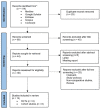Comparison of laparoscopic sacrocolpopexy with vaginal reconstructive procedures and abdominal sacrocolpopexy for the surgical management of vaginal vault prolapse: a systematic review and meta-analysis
- PMID: 37766917
- PMCID: PMC10520704
- DOI: 10.3389/fmed.2023.1269214
Comparison of laparoscopic sacrocolpopexy with vaginal reconstructive procedures and abdominal sacrocolpopexy for the surgical management of vaginal vault prolapse: a systematic review and meta-analysis
Abstract
Introduction: Vaginal vault prolapse, also known as apical prolapse, is a distressing condition that may affect women following hysterectomy, necessitating surgical intervention when conservative measures prove ineffective. The surgical management of apical compartment prolapse includes procedures such as laparoscopic sacrocolpopexy (LSCP), abdominal sacrocolpopexy (ASCP) or vaginal reconstructive procedures (VRP). This systematic review and meta-analysis aims to compare the outcomes of these interventions.
Methods: A comprehensive search of electronic databases was conducted to identify eligible studies. Fourteen studies comprising a total of 1,289 women were included. The selected studies were analyzed to evaluate outcomes such as duration of surgery, length of hospital stay, blood loss, complication rates, and patient satisfaction.
Results: LSCP did not demonstrate significant advantages over VRP in terms of perioperative or long-term outcomes. However, when compared to ASCP, LSCP showed shorter hospital stay, reduced blood loss, decreased postoperative pain, and lower rates of ileus.
Discussion: This systematic review contributes to evidence-based decision-making for the surgical treatment of vaginal vault prolapse. While LSCP did not exhibit substantial benefits over VRP, it emerged as a preferable option compared to ASCP due to shorter hospital stays and reduced postoperative complications. The findings from this study provide valuable insights for clinicians and patients in selecting the most appropriate surgical approach for vaginal vault prolapse. However, future research should focus on long-term follow-ups, standardizing outcomes, and outcome measures, and evaluating cost-effectiveness to further enhance clinical practice.
Keywords: apical prolapse; cohort study; meta-analysis; randomized trial; sacrocolpopexy; sacrospinous fixation; vaginal mesh; vault prolapse.
Copyright © 2023 Ciortea, Roman, Măluțan, Bucuri, Ormindean, Nati and Mihu.
Conflict of interest statement
The authors declare that the research was conducted in the absence of any commercial or financial relationships that could be construed as a potential conflict of interest.
Figures





References
Publication types
LinkOut - more resources
Full Text Sources

